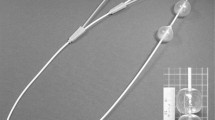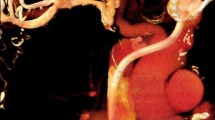Abstract
Purpose
To study venous injury caused by a prototype percutaneous mechanical thrombolytic device.
Methods
Simulated thrombolysis was performed using the device, or the Fogarty balloon catheter (FBC) as control, in the infrarenal inferior vena cava (IVC) of 40 New Zealand white rabbits. Venous injury was evaluated by cavography, Evans blue dye staining, and histology at 0, 1, and 6 weeks postprocedure.
Results
Both devices resulted in near complete endothelial denudation acutely. No differences in reendothelialization were noted at any time in the proximal and mid-IVC, but there was significantly greater reendothelialization in the distal IVC in the rabbits treated 6 weeks earlier with the device (p ≤ 0.04). Additionally, the inner luminal diameter at necropsy for the 1-week rabbits treated with the FBC was significantly narrower in the distal and middle sections of the IVC when compared with the device (p ≤ 0.02 for both segments). There was no luminal diameter difference at 0 or 6 weeks.
Conclusion
Based on a rabbit model, venous injury from the device was found to be similar to, and in the distal IVC less than, the routinely used FBC.
Similar content being viewed by others
References
Kensey KR, Nash JE, Abrahams C, Zarins CK (1987) Recanalization of obstructed arteries with a flexible, rotating tip catheter. Radiology 165:387–389
Bildsoe MC, Moradian GP, Hunter DW, Castañeda-Zúñiga WR, Amplatz K (1989) Mechanical clot dissolution: New concept. Radiology 171:231–233
Schmitz-Rode T, Günther RW (1991) New device for percutaneous fragmentation of pulmonary emboli. Radiology 180:135–137
Schmitz-Rode T, Günther RW (1991) Percutaneous mechanical thrombolysis: A comparative study of the various rotational catheter systems. Invest Radiol 26:557–563
Günther RW, Vorwerk D (1990) Aspiration catheter for percutaneous thrombectomy: Clinical results. Radiology 175:271–273
Schmitz-Rode T, Pfeffer JG, Bohndorf K, Günther RW (1993) Percutaneous thrombectomy of the acutely thrombosed dialysis graft: In vitro evaluation of four devices. Cardiovasc Intervent Radiol 16:72–75
Drasler WJ, Jenson ML, Wilson GJ, Thielen JM, Protonotarios EI, Dutcher RG, Possis ZC (1992) Rheolytic catheter for percutaneous removal of thrombus. Radiology 182:263–267
Greep JM, Aleman PJ, Jarrett F, Bast TJ (1972) A combined technique for peripheral arterial embolectomy. Arch Surg 105:869–874
Lassers BW, Pickering D (1967) Removal of an iatrogenic foreign body from the aorta by means of a ureteric stone catheter. Am Heart J 73:375–378
Harinck E, Rohmer J (1974) Atraumatic retrieval of catheter fragments from the central circulation in children. Eur J Cardiology 1:421–422
Günther RW, Vorwerk D (1991) Minibasket for percutaneous embolectomy and filter protection against distal embolization: Technical note. Cardiovasc Intervent Radiol 14:195–198
Starck EE, McDermott JC, Crummy AB, Turnipseed WD, Acher CW, Burgess JH (1985) Percutaneous aspiration thromboembolectomy. Radiology 156:61–66
Vorwerk D, Günther RW, Clerc C, Schmitz-Rode T, Imbert C (1992) Percutaneous embolectomy: In vitro investigations of the self-expanding tulip sheath. Radiology 182:415–418
Zimmerman JJ, Cipriano PR, Hayden WG, Fogarty TJ (1986) Balloon embolectomy used percutaneously. Radiology 158:260–262
Ponomer E, Carlson JE, Kindlund A, Rodriguez JP, Casteñeda-Zúñiga WR, Hunter DW, Yedlicka JW, Amplatz K (1991) Clottrapper device for transjugular thrombectomy from the inferior vena cava. Radiology 179:279–282
Trerotola SO, Lund GB, Savader SJ, Venbrux AC, Osterman FA (1992) Percutaneous thrombectomy device: Preliminary clinical experience with follow-up. 78th Scientific Assembly and Annual Meeting of RSNA, Nov 29–Dec 4, 1992
Barone GW, Conerly JM, Farley PC, Flanagan TL, Kron IL (1989) Endothelial injury and vascular dysfunction associated with the Fogarty balloon catheter. J Vasc Surg 9:422–425
Clowes AW, Reidy MA, Clowes MM (1983) Mechanism of stenosis after arterial injury. Lab Invest 49:208–215
Reidy MA, Standaert D, Schwartz SM (1982) Inhibition of endothelial cell regrowth: Cessation of aortic endothelial cell replication after balloon catheter denudation. Arteriosclerosis 2:216–220
Hirsch EZ, Robertson AL (1977) Selective acute arterial injury and repair. I. Methodology and surface characteristics. Atherosclerosis 28:271–287
Chidi CC, DePalma RG (1978) Atherogenic potential of the embolectomy catheter. Surgery 83:549–557
Walker LN, Ramsay MM, Bowyer DE (1983) Endothelial healing following defined injury to rabbit aorta: Depth of injury and mode of repair. Atherosclerosis 47:123–130
Cotran RS, Kumar V, Robbins SL (1989) Robbins pathologic basis of disease. Harcourt Brace Jovanovich, Philadelphia, pp 554–556, 566–567
Manderson JA, Campbell GR (1986) Venous response to endothelial denudation. Pathology 18:77–87
Reidy MA, Schwartz SM (1981) Endothelial regeneration. III. Time course of intimal changes after small defined injury to rat aortic endothelium. Lab Invest 44:301–308
Fishman JA, Ryan GB, Karnovsky MJ (1975) Endothelial regeneration in the rat carotid artery and the significance of endothelial denudation in the pathogenesis of myointimal thickening. Lab Invest 32:339–351
Goff SG, Wu H, Sauvage LR, Usui Y, Wechezak AR, Coan DE, Arnell RE, Walker MW (1988) Differences in reendothelialization after balloon catheter removal of endothelial cells, superficial endarterectomy, and deep endarterectomy. J Vasc Surg 7:119–129
Moore N, Belbeck LW, Richardson M, Taylor W (1982) Lipid accumulation in the neointima formed in normally fed rabbits in response to one or six removals of the aortic endothelium. Lab Invest 47:37–42
Painter TA (1990) Myointimal hyperplasia: Pathogenesis and implications. 2. Animal injury models and mechanical factors. Artif Organs 15:103–118
Ross R (1986) The pathogenesis of atherosclerosis. An update. N Engl J Med 314:488–500
Fogarty TJ, Cranley JJ, Krause RJ, Strasser ES, Hafner CD (1963) A method for the extraction of arterial emboli and thrombi. Surg Gynecol Obstet 116:241–244
Fogarty TJ, Cranley JJ (1965) Catheter technique for arterial embolectomy. Ann Surg 161:325–330
Byrnes G, MacGowan WA (1975) The injury potential of Fogarty balloon catheters. J Cardiovasc Surg 16:590–593
Foster JH, Carter JW, Graham CP, Edwards WH (1970) Arterial injuries secondary to the use of the Fogarty catheter. Ann Surg 171:971–978
Mavor GE, Walker MG, Dahl DP, Pegg CA (1972) Damage from the Fogarty balloon catheter. Br J Surg 59:389–391
Dainko EA (1972) Complications of the use of the Fogarty balloon catheter. Arch Surg 105:79–82
Goldberg EM, Goldberg MC, Chowdhury LN, Gould SA (1983) The effects of embolectomy-thrombectomy catheters on vascular architecture. J Cardiovasc Surg 24:74–80
Dobrin PB (1989) Mechanisms and prevention of arterial injuries caused by balloon embolectomy. Surgery 106:457–466
Schwarcz TH, Dobrin PB, Mrkvicka R, Skowron L, Cole MB (1988) Early myointimal hyperplasia after balloon catheter embolectomy: Effect of shear forces and multiple withdrawals. J Vasc Surg 7:495–499
Bjorkerud S, Bondjers G (1973) Arterial repair and atherosclerosis after mechanical injury. Part 5. Tissue response after induction of a large superficial transverse injury. J Atheroscler Res 18:235–255
Haudenschild CC, Schwartz SM (1979) Endothelial regeneration. II. Restitution of endothelial continuity. Lab Invest 41:407–418
Jorgensen RA, Dobrin PB (1983) Balloon embolectomy catheters in small arteries. IV. Correlation of shear forces with histologic injury. Surgery 93:798–808
Dobrin PB (1981) Balloon embolectomy catheters in small arteries. I. Lateral wall pressures and shear forces. Surgery 90:177–184
Author information
Authors and Affiliations
Rights and permissions
About this article
Cite this article
Lajvardi, A., Trerotola, S.O., Strandberg, J.D. et al. Evaluation of venous injury caused by a percutaneous mechanical thrombolytic device. Cardiovasc Intervent Radiol 18, 172–178 (1995). https://doi.org/10.1007/BF00204145
Issue Date:
DOI: https://doi.org/10.1007/BF00204145




